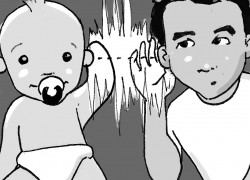
Researchers have determined that baby talk isn’t as trivial as we once thought. U. California-San Diego professors conducted a study showing that babies just over a year old use the same neurological pathways in the brain when processing language as do adults.
Using MEG and MRI scans, radiology professor Eric Halgren and his research team located the structures in the brain where the infants process language.
“The neurobiological process that babies use to understand words is the same as the processes used by adults,” Halgren said. “It’s in the same place, it’s happening at the same time — more or less — and it is using the same neurocircuits.”
In the study, babies between 14 to 18 months were shown pictures and then played a sound that did or did not match the picture. The neurons relating to words and meanings sent electrical currents, which then produced magnetic fields, which were observed using imaging technology.
“That’s how we were able to probe whether this [brain]wave was related to meaning, because babies had the meaning in their head from looking at the picture, and then we got a differential response depending on whether it — the word — matched the picture, or didn’t,” Halgren said.
The amplitude of the brain wave determined whether the infants identified the correlation between the word and the picture. The mismatched words caused a characteristic brain wave that has also commonly been associated with word meaning in adults in the left front temporal region.
“If you do this in adults, you get this characteristic wave that is called the n400,” Halgren said. “It peaks about 400 ms after the onset of the word, and so it’s called the n400.”
Previously, scientists believed that babies used different pathways to process words from studies done in other parts of the brain. According to Halgren, if these regions in adult brains have lesions, the person loses his ability process to comprehend language. If a newborn has lesions in these areas, however, they are still able to develop language normally.
“Other ideas include that maybe [processing language] involved the frontal lobe, or it involved the right hemisphere, or maybe was all over the place, and gradually, it got concentrated,” Halgren said.
The researchers conclusion determine early signs of mental developmental issues in children.
